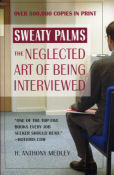| What REALLY goes on in a job interview? Find out in the new revision of "Sweaty Palms: The Neglected Art of Being Interviewed" (Warner Books) by Tony Medley, updated for the world of the Internet . Over 500,000 copies in print and the only book on the job interview written by an experienced interviewer, one who has conducted thousands of interviews. This is the truth, not the ivory tower speculations of those who write but have no actual experience. "One of the top five books every job seeker should read," says Hotjobs.com. | |
| Next (8/10) by Tony Medley Nicolas Cage is the movie star for the ordinary man. Heís the guy you look at and say, ďIf this guy can be a movie star, why canít I?Ē I donít know what makes womenís heart flutter, but I bet itís not Nicolas. I can understand Brad Pitt, and maybe even the diminutive Tom Cruise, this generationís answer to Alan Ladd, all five feet-five of him. But Nicolas Cage? So for Nicolas Cage to win the heart of a cutie like Jessica Biel, as he does here, he must have something not visible to my naked eye. That, actually, was the biggest plot hole in this, and every time warper has, by definition, a lot of plot holes. But for Nicolas to come up to Jessica cold, and walk off with her heart in his hand, well, it strains my credulity. Then, again, with this as evidence, maybe the next time I see Jessica Iíll ask her if she wants to go bowling with me. Cris (Nicolas Cage) is a performer of magic tricks in a Las Vegas casino. The problem is, what he does is no trick. He can actually see into the future, but only two minutes into the future, but thatís enough to get him involved in a life-altering affair. The thing thatís different about this time-warper is that Cris can see alternative scenarios in the future. Knowing that, he can change what he sees happening. Some terrorists (not Islamic, mystifyingly) want to explode an atomic bomb somewhere in Los Angeles (where else?) and FBI agent Callie Ferris (Julianne Moore) is trying to stop them. She sees Cris do his act and believes him, but he doesnít want any part of her. Cris uses his powers and gets in trouble with a casino, so he goes on the run. Enter Liz (Jessica Biel) a woman Cris has ďseenĒ with his extra sensory perception, and wants to meet. This is the basis for Director Lee Tamahoriís intriquing time warp thriller, from another screenplay with multiple credits (Gary Goldman, Jonathan Hensleigh, and Paul Bernbaum). Multiple credits often mean a bad film. Here, Goldman optioned a Philip K. Dick short story, ďThe Golden ManĒ and wrote a screenplay on spec. He then interested Cage and Saturn films and took the package to Revolution Studios who liked enough to proceed with the project. Whatever the cause for so many additional writers, Tamahori has achieved something better than the sum of its parts because this is a well-acted, interesting venture. There are lots of real locations that add to the romance of the film, The Grand Canyon in Arizona, the Port of Long Beach, Big Bear Lake and Lake Arrowhead, where the mountain sequences were shot. The time warps are interesting in that the audience often canít tell whatís actually happening or what Cris is projecting will happen if he doesnít do something else. All time warp movies have plot holes, by definition. The concept of a time warp is impossible, Einstein to the contrary notwithstanding. So to make a story based on something impossible, the story itself must have some logical flaws. The brilliance of a good time warper is that the storytellers get you to believe that what you are watching is logical enough for you to dispense with your disbelief. Thatís what happens here. Itís not possible to go into the story of a time warp movie without ruining it for the audience. Suffice it to say that Iím a big time warp movie fan and this is a good one. April 26, 2007
|
|
|
|
|
